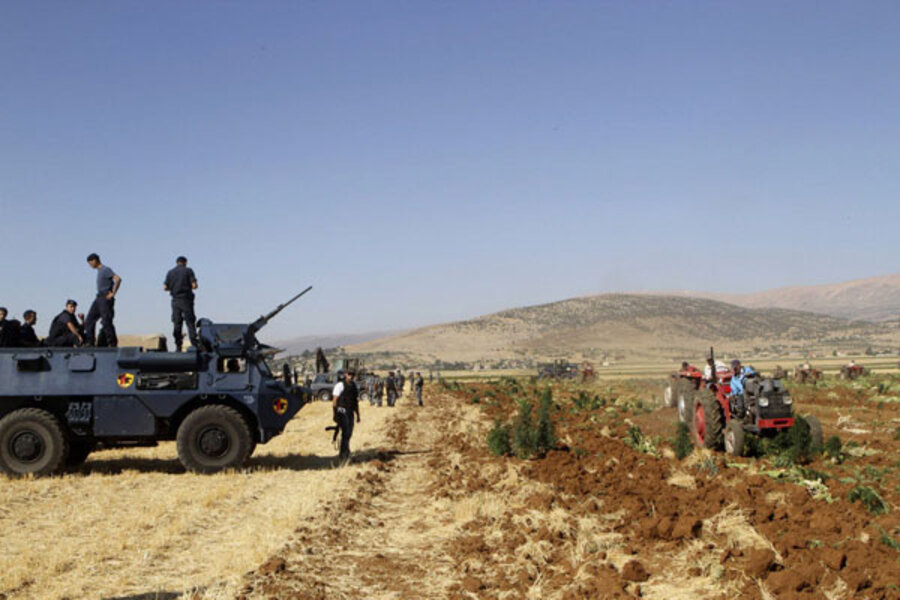Farmers, government battle over hashish in Lebanon's Bekaa Valley
| Yammouneh, east Lebanon
Three of Lebanon’s fiercely independent Shiite tribes in the Bekaa Valley banded together and fought gun battles last week with soldiers and police to thwart an annual mission to destroy fields of lucrative hashish.
The unusually heavy armed resistance from the powerful tribes, which ended with several soldiers shot and wounded, appears to have forced the Lebanese government to address long-standing economic and social welfare grievances in this remote corner of east Lebanon.
During the lawless years of Lebanon’s 1975-1990 civil war, the fertile plain of the Bekaa Valley was awash with fields of green saw-toothed cannabis sativa plants, generating some $500 million annually. But a government-run eradication program in the early 1990s came close to halting production, and in 1997 Lebanon was removed from the United States’ list of the world’s top drug-producing countries. International donor countries were expected to fund developments projects for the northern Bekaa, which would allow farmers to profitably grow legal crops.
But the donor funds never materialized. Past Lebanese governments blamed the donors for reneging on their promises, while the donor nations accused Beirut of failing to draw up adequate development projects.
As a result, farmers have returned to hashish cultivation over the past decade, despite annual attempts by the government to destroy the crops.
“If they let us grow hashish for three years, we would generate enough money to allow Lebanon to repay its debt,” jokes Jamal Sharif, the mayor of Yammouneh, referring to Lebanon’s staggering gross public debt of $55 billion.
A kilogram (2.2 pounds) of apples is worth 30 cents, while a kilogram of processed cannabis resin is worth $1,700, which explains the preference for hashish cultivation.
“In Yammouneh, we grow either apples or hashish. That’s all that will grow here because there’s not enough water to irrigate other crops. It’s not a hobby to grow hashish; we do it to survive,” says Mr. Sharif.
Getting the government's attention
On Aug. 4, residents of Yammouneh, a small village lying at the foot of soaring sepia-colored mountains, blocked the road with burning tires to prevent Lebanese soldiers and police from gaining access to the hashish fields. Clashes erupted elsewhere when heavily armed tribesmen attacked soldiers and police en route to the fields.
“He hasn’t slept for five days because of the fighting,” says one of two bodyguards to Ali, one of the largest hashish growers in the Bekaa Valley, who was dozing on a swing seat outside a house on top of a wooded hill a few miles from Yammouneh. Ali agreed to speak to meet with the Monitor on condition of anonymity.
An M-16 rifle leans against a wall and another fitted with a grenade launcher lies on a cot alongside a vest packed with grenades, all of them within easy reach in case the authorities return.
The fighting spurred Marwan Charbel, the Lebanese interior minister, to visit Yammouneh on Aug. 5, where he promised to provide compensation to the hashish farmers. Today the government announced the formation of a committee to come up with an economic development program for the Baalbek-Hermel district of the northern Bekaa Valley.
“Its task will be to forward swift and practical proposals to address the suffering of Baalbek-Hermel and make its proposals within a month,” said Wael Abu Faour, acting information minister.
Better incentives needed
A field of waist-high green hashish plants planted in the center of the village sways in the cool breeze. This one field alone will produce approximately seven kantars (3,850 pounds; a Kantar is an Arabic measurement of weight) of green hashish, which will generate 30.8 pounds of refined product worth $23,800 on the black market.
The farmers claim that a fraction of this year’s crop has been destroyed. With the tribes beginning to unite, the government had no choice but to strike a deal, the farmers say.
“The political factions are always trying to keep the tribes split,” says Sharif. “This time we said no and signed a deal. When the government decided to come after our hashish, we joined forces to confront them.”
The three tribes are the Jaafars, the Shammas, and the Sharifs, the largest and strongest in this corner of the Bekaa. The alliance’s success in confronting the government and checking the eradication campaign has spurred other tribes in the far north of the Bekaa to consider also uniting to protect their own hashish fields.
Still, given past experience, the residents of Yammouneh are skeptical that the government will fulfill its promise to provide compensation and launch development projects for the impoverished region.
“They need to give us something else to grow so that we have another way to make a living,” says Hassan Sharif (almost all residents of Yammouneh are from the Sharif tribe). “It’s not enough to receive a one-off compensation. Otherwise, we’ll keep on growing hashish.”





